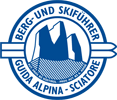Backcountry skiing in the Dolomites with your local IFMGA mountain guide
Skiing in the backcountry is a very enjoyable alternative to dive into the untouched white nature.
Thanks to new, light binding systems and a steady evolution in the ski sector, today everyone can manage longer skitour ascents with a little practice and condition. In short: with some good planning and strategic breaks, nothing will deter you from your backcountry skiing challenge.
I would love to take you skiing in the backcounty around the Dolomites and planning a tour based on current conditions, considering your fitness level and personal goals. If desired, I will also help you to improve your skills off-piste to ensure a safe and enjoyable winter adventure. For further information and bookings please contact me as soon as possible!
The Dolomites offer a huge variety of backcountry and ski tours.
Each time I clip on my skies…
I am drawn in by the beauty of winter in all its facets.
In South Tyrol, the Dolomites and the Alps, there are countless backcountry skiing tours for a multitude of people. There is simply something for everyone.
Furthermore, many manufacturers are offering an increasing number of lighter binding systems and ski boots and developing a variety of backcountry skiing gear. As a result, pretty much anyone can tackle longer ascents with a little practice and fitness. If needed, the latest equipment can be rented in one of the local ski rentals.
So nothing stands in the way to head up for your next adventure off-piste in the Dolomites UNESCO world heritage. If you are interested, please get in touch with me. A short chat and a cup of coffee can turn your dream into reality.
Your equipment can be rented on site. Here is your packing list for ski tour/off-piste. You will find further information under prices.
Here is a small selection of my guided backcountry skiing tours in the Dolomites:
 Lift-assisted freeriding in Gardena Valley and Val Lasties
Lift-assisted freeriding in Gardena Valley and Val Lasties
For backcountry lovers, the Passo Pordoi and Val Lasties decents are a great start to a vacation in the Dolomites with a local mountain guide.
The backcoutry descent through the “Val Lasties” valley is a great tour with 1,100 m of downhill. The valley is easily accessible and offers amazing panoramic views of the Dolomites – the UNESCO World heritage mountain range in northern Italy. Furthermore, the entire ski area around the Passo Pordoi cable […]
 Easy backcountry ski tour for beginners: The Christspitze (2592m)
Easy backcountry ski tour for beginners: The Christspitze (2592m)
The off-piste descent the Christspitze peak with a mountain guide offers a great wind-protected downhill area in deep snow with moderate difficulties
Beginners of ski touring will really enjoy the winter wonderland of the Alpe di Siusi. Furthermore, ski pass holders can shorten the ascent and transform this tour into a mixture of lift-assisted off-piste and backcountry skiing tour. For those who want to ascend by themselves and feel the snow under […]
 Extreme backcountry ski tour for experts: The Seiser Klamm
Extreme backcountry ski tour for experts: The Seiser Klamm
The extreme backcountry descent of the gorge “Seiser Klamm” (1.300m) offers a steep downhill couloir
Considering that the Schlern (local mountain of my home town) is the emblem of South Tyrol, the attraction of this extreme descent through the steep couloir of its gorge is undeniable. A ski tour at the Seiser Klamm gorge requires good snow conditions as well as good skiing skills. The […]
 Advanced backcountry ski tour: The Plattkofel (2995m) – highest peak of the Alpe di Siusi
Advanced backcountry ski tour: The Plattkofel (2995m) – highest peak of the Alpe di Siusi
Guided ski tour to the Plattkofel - one of the most photographed landmarks of the Dolomites.
The Plattkofel is one of the few peaks of the Dolomites, which can be conquered on skies. The Plattkofel peak is 2900meter high and situated in the region Alpe di Siusi, in South Tyrol – Northern Italy. Depending on the ascent route, either 918 or 1250 meter of altitude will […]
As a mountain guide, I offer also ski touring weeks in the Lofoten Islands, allowing enthusiasts to explore the breathtaking Arctic landscape with expert guidence. More details can be found here.
Good to know: the meaning of different types of snow and equipment
Just watching the snowfall fills each ski tourer heart with positive thoughts. The anticipation of the next backcountry ski tour increrases. It’s high time to study the tour map and check the weather stations. The next outdoor adventure is taking shape!
It hardly seems credible, but in terms of safety, the more snow the better for each ski tour. The weight of the snow has, amongst other things, a positive effect on the snow profile
Powder snow or fresh snow:
Sometimes fresh new snow makes every descent in deep snow easier. Even inexperienced skiers will find good opportunities to draw a good line in the snow. It’s not just the snowflakes that fall softly, we ski tourers also fall softly when a set turn doesn’t fit in powder snow. In the best conditions, even up to 30 cm of fresh snow can be harmless for the avalanche situation. Great pictures, wonderful snow-covered forests and good memories round off the day in the white.
Blowing snow
The wind is the master builder of avalanches. That’s why we ski tourers hate it like the plague. Firstly, it has the ability to press loose snow into each other and thus create unfavorable snow cover situations. Secondly, the crystals carried by the wind hurt your face. Not a good deal! Drifting snow can also settle with the sun’s rays. As a result, after a few days, the situation can become friendly again for us winter freaks.
These snow drifts are accompanied by sastrugi, cornices and snow dunes. Experienced ski tourers can read the wind direction from them.
Harsch
The longer the day and the stronger the sunlight (or wind), the more intense the effect on our beloved snow cover. As a result, the uppermost layers of a snow cover tend to melt. The low temperatures of the night cause them to freeze again and form a hard, thin layer of small crystals on the surface. The snowflake has lost its wonderful ramifications. What remains is a layer that is often unsupportable for us ski tourers (broken snow). We break in, our wedeling becomes laborious. A proper downhill style, wide skis and strength can save us to some extent. Hopefully we will find better conditions at lower altitudes and in the forest.
Firn
Firn is the old brother of hard snow. A friendly companion if you choose the right time of day for the descent. Still frozen hard in the early morning (spring), it can soften in the late morning and support the descent with wonderful conditions. At the beginning of the sport of ski touring, tours were almost exclusively carried out in just such conditions. An early start, good tour planning, reaching the summit at the right time and with the right amount of sunlight on the downhill slope is as enjoyable as on the ski slopes. In addition, the risk of avalanches is reduced to a minimum.
Lazy snow
Lazy snow is a gritty, coarse-grained affair. You will come across it if you are out and about too late in the spring. The firn continues to rise and you sink deeper and deeper into the snow cover. The pleasant, easy to ski on melted firn layer several centimetres deep has left us. The danger of avalanches is now increasing rapidly.
The lunch aperitif had to wait too long for our sunburnt faces.
Wild snow (Champaign Powder)
We Alpine Europeans rarely get to experience real wild snow. It forms at the coldest temperatures from moisture in the air and trickles down to the ground. A similar variant could be blown snow deposited in wind-protected gullies. It is small-grained and fluffy. Fun to ski in!
Ski touring skis
Now we are tackling a really diverse and extensive topic. That means 1000 people, 1000 opinions and possibilities.
As a recommendation, as a golden mean, I nevertheless recommend the following. A touring ski should have between 88-98mm in the center of the ski and weigh between 1300gr. and 1500gr. per ski. I would set the length up to your height.
With longer models, which may be more than your height, there are again problems with the hairpin turns. This is not conducive to ascents in spring, in tough conditions, on steep terrain and costs additional energy. With models that are too short, on the other hand, the skier needs a lot of balance to control the ski. Short or very long skis, only for advanced and good skiers.
Ski touring bindings
„According to me, the ski touring binding systems are somewhat simpler. A descent in powder snow is generally forgiving of minor errors in stance and power transmission via the binding systems. In broken snow, however, the situation is somewhat different. However, here too, the normal ski tourer will never reach the maximum loads of professionals. That’s why I advocate classic pin bindings with stoppers (weight 300-500gr.). Closed on the ascent and open on the descent, I have never had any problems with the binding opening on its own on the descent.
I personally don’t need a heavy frame freeride binding with a camber release value, I prefer to focus on technique training.
Ski touring boots
The ski touring boot should have a certain stability, i.e. not be too light. In my opinion, however, the shape of the foot takes precedence over the brand. Try, try and try again, eventually one will fit. You’ll feel it immediately. Sore feet spoil every ski safari.
Crampons
The crampon is a climbing aid in hard frozen snow and works in much the same way as a crampon on skis. This curved “thing” made of hardened aircraft aluminum is guaranteed to be in your backpack next to your bivy sack in autumn. They are available in any size and for any binding and ski.









